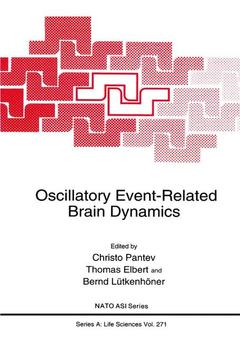Oscillatory Event-Related Brain Dynamics, Softcover reprint of the original 1st ed. 1994 NATO Science Series A: Series, Vol. 271
Langue : Anglais
Coordonnateurs : Pantev Christo, Elbert Thomas, Lütkenhöner Bernd

How does the brain code and process incoming information, how does it recog nize a certain object, how does a certain Gestalt come into our awareness? One of the key issues to conscious realization of an object, of a Gestalt is the attention de voted to the corresponding sensory input which evokes the neural pattern underly ing the Gestalt. This requires that the attention be devoted to one set of objects at a time. However, the attention may be switched quickly between different objects or ongoing input processes. It is to be expected that such mechanisms are reflected in the neural dynamics: Neurons or neuronal assemblies which pertain to one object may fire, possibly in rapid bursts at a time. Such firing bursts may enhance the synaptic strength in the corresponding cell assembly and thereby form the substrate of short-term memory. However, we may well become aware of two different objects at a time. How can we avoid that the firing patterns which may relate to say a certain type of move ment (columns in V5) or to a color (V 4) of one object do not become mixed with those of another object? Such a blend may only happen if the presentation times be come very short (below 20-30 ms). One possibility is that neurons pertaining to one cell assembly fire syn chronously. Then different cell assemblies firing at different rates may code different information.
A Comparative Survey of Event Related Brain Oscillations; T.H. Bullock, J.Z. Achimowicz. Physiologic and Epileptic Oscillations in a Small Invertebrate Network; U. Altrup, et al. Corticohippocampal Interplay: Synopsis of a Theory; R. Miller. Coherent Assembly Dynamics in the Cortex: Multineuron Recordings, Network Simulations, and Anatomical Considerations; A. Aertsen, et al. Temporal Aspects of Information Processing in Areas V1 and V2 of the Macaque Monkey; L.G. Nowak, et al. Oscillations and Synchrony in the Visual Cortex: Evidence for Their Functional Relevance; P.R. Roelfsema, et al. Oscillatory and Nonoscillatory Synchronizations in the Visual Cortex of Cat and Monkey; R. Eckhorn. Event Related Changes in the 40 Hz Electroencephalogram in Auditory and Visual Reaction Time Tasks; H. Jokeit, et al. Attentional Effects on Image-Motion Related Potentials and Spectral Perturbations; M. Valdes-Sosa, et al. Retinal and Cortical Oscillatory Responses to Patterned and Unpatterned Visual Stimulation in Man; W.G. Sannita. 21 additional articles. Index.
Date de parution : 06-2013
Ouvrage de 468 p.
17.8x25.4 cm
Disponible chez l'éditeur (délai d'approvisionnement : 15 jours).
Prix indicatif 210,99 €
Ajouter au panierThèmes d’Oscillatory Event-Related Brain Dynamics :
Mots-clés :
attention; brain; cortex; electroencephalography (EEG); information processing; memory; neurons
© 2024 LAVOISIER S.A.S.



